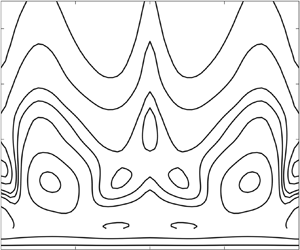Article contents
Effects of streamwise-elongated and spanwise-periodic surface roughness elements on boundary-layer instability
Published online by Cambridge University Press: 27 July 2020
Abstract

We investigate the impact on the boundary-layer stability of spanwise-periodic, streamwise-elongated surface roughness elements. Our interest is in their effects on the so-called lower-branch Tollmien–Schlichting modes, and so the spanwise spacing of the elements is taken to be comparable with the spanwise wavelength of the latter, which is of  $O(R^{-3/8} L)$, where
$O(R^{-3/8} L)$, where  $L$ is the dimensional length from the leading edge of the flat plate to the surface roughness, and
$L$ is the dimensional length from the leading edge of the flat plate to the surface roughness, and  $R$ is the Reynolds number based on
$R$ is the Reynolds number based on  $L$. The streamwise length is much longer, consistent with experimental set-ups. The roughness height is chosen such that the wall shear is altered by
$L$. The streamwise length is much longer, consistent with experimental set-ups. The roughness height is chosen such that the wall shear is altered by  $O(1)$. From the generic triple-deck theory for three-dimensional roughness elements with both the streamwise and spanwise length scales being of
$O(1)$. From the generic triple-deck theory for three-dimensional roughness elements with both the streamwise and spanwise length scales being of  $O(R^{-3/8 }L)$, we derived the relevant governing equations by appropriate rescaling. The resulting equations are nonlinear but parabolic because the pressure gradient in the streamwise direction is negligible while in the spanwise direction it is completely determined by the roughness shape. Appropriate upstream, boundary and matching conditions are derived for the problem. Owing to the parabolicity, the equations are solved efficiently using a marching method to obtain the streaky flow. The instability of the streaky flow is shown to be controlled by the spanwise-dependent (periodic) wall shear. Two- and weakly three-dimensional lower-frequency modes are found to be stabilised by the streaks, confirming previous experimental findings, while stronger three-dimensional and higher-frequency modes are destabilised. Among the three roughness shapes considered, the roughness elements in the form of hemispherical caps are found to be most effective for a given height. A resonant subharmonic interaction was found to occur for modes with spanwise wavelength twice that of the roughness elements.
$O(R^{-3/8 }L)$, we derived the relevant governing equations by appropriate rescaling. The resulting equations are nonlinear but parabolic because the pressure gradient in the streamwise direction is negligible while in the spanwise direction it is completely determined by the roughness shape. Appropriate upstream, boundary and matching conditions are derived for the problem. Owing to the parabolicity, the equations are solved efficiently using a marching method to obtain the streaky flow. The instability of the streaky flow is shown to be controlled by the spanwise-dependent (periodic) wall shear. Two- and weakly three-dimensional lower-frequency modes are found to be stabilised by the streaks, confirming previous experimental findings, while stronger three-dimensional and higher-frequency modes are destabilised. Among the three roughness shapes considered, the roughness elements in the form of hemispherical caps are found to be most effective for a given height. A resonant subharmonic interaction was found to occur for modes with spanwise wavelength twice that of the roughness elements.
- Type
- JFM Papers
- Information
- Copyright
- © The Author(s), 2020. Published by Cambridge University Press
References
REFERENCES
- 6
- Cited by


